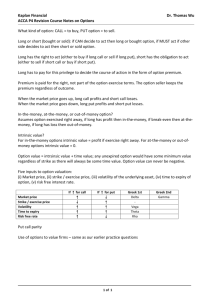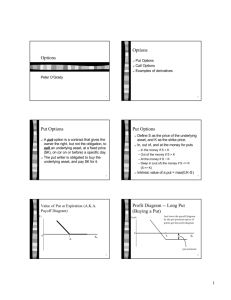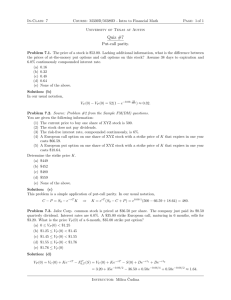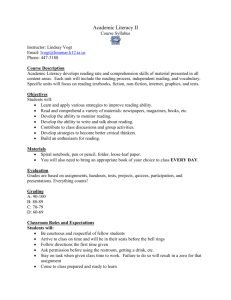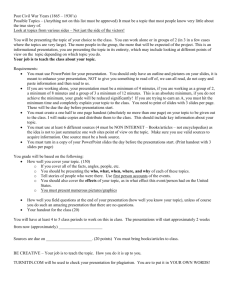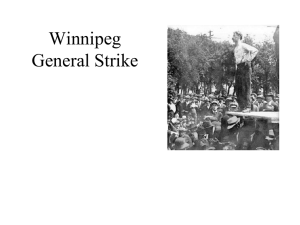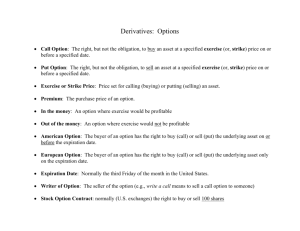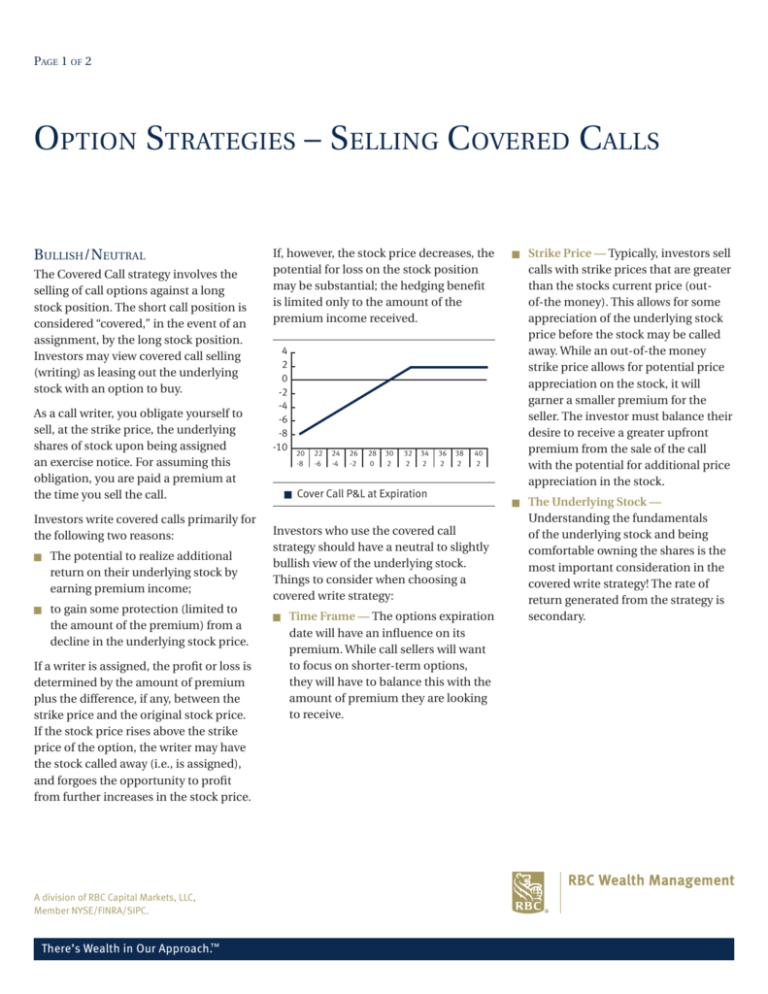
Page 1 of 2
Option Strategies – Selling Covered Calls
Bullish/Neutral
The Covered Call strategy involves the
selling of call options against a long
stock position. The short call position is
considered “covered,” in the event of an
assignment, by the long stock position.
Investors may view covered call selling
(writing) as leasing out the underlying
stock with an option to buy.
As a call writer, you obligate yourself to
sell, at the strike price, the underlying
shares of stock upon being assigned
an exercise notice. For assuming this
obligation, you are paid a premium at
the time you sell the call.
Investors write covered calls primarily for
the following two reasons:
nThe potential to realize additional
return on their underlying stock by
earning premium income;
nto gain some protection (limited to
the amount of the premium) from a
decline in the underlying stock price.
If a writer is assigned, the profit or loss is
determined by the amount of premium
plus the difference, if any, between the
strike price and the original stock price.
If the stock price rises above the strike
price of the option, the writer may have
the stock called away (i.e., is assigned),
and forgoes the opportunity to profit
from further increases in the stock price.
A division of RBC Capital Markets, LLC,
Member NYSE/FINRA/SIPC.
There’s Wealth in Our Approach.™
If, however, the stock price decreases, the
potential for loss on the stock position
may be substantial; the hedging benefit
is limited only to the amount of the
premium income received.
4
2
0
-2
-4
-6
-8
-10
20
-8
22
-6
24
-4
26
-2
28
0
30
2
32
2
34
2
36
2
38
2
40
2
n Cover Call P&L at Expiration
Investors who use the covered call
strategy should have a neutral to slightly
bullish view of the underlying stock.
Things to consider when choosing a
covered write strategy:
n
Time Frame — The options expiration
date will have an influence on its
premium. While call sellers will want
to focus on shorter-term options,
they will have to balance this with the
amount of premium they are looking
to receive.
n
Strike Price — Typically, investors sell
calls with strike prices that are greater
than the stocks current price (outof-the money). This allows for some
appreciation of the underlying stock
price before the stock may be called
away. While an out-of-the money
strike price allows for potential price
appreciation on the stock, it will
garner a smaller premium for the
seller. The investor must balance their
desire to receive a greater upfront
premium from the sale of the call
with the potential for additional price
appreciation in the stock.
n
The Underlying Stock —
Understanding the fundamentals
of the underlying stock and being
comfortable owning the shares is the
most important consideration in the
covered write strategy! The rate of
return generated from the strategy is
secondary.
Page 2 of 2 | Option Strategies – Selling Covered Calls, continued
Example:
Stock XYZ is trading at $32/share.
Three month call options:
Strike Price
Premium
32.5
$4.50
35
$3.50
40
$2.00
Assuming the stock is purchased at $32
and the calls are sold at the above prices,
the results (at expiration) for each strike
price are shown below.
10
P & L at Expiration
8
6
4
2
0
-2
-4
-6
An important concept of covered writing
is the capping effect of the short call. The
maximum profit in a covered call position
is capped at the difference between the
purchase price of the stock and the strike
price of the call plus the premium of
the option. The table below shows the
expiration results for various strike prices
over different stock levels. You can see the
tradeoff between the option premium
and the strike price. If premium income
is the main objective you may choose
to sell the $32.5 strike call. This option
brings in the most upfront premium.
It also, by virtue of the lower strike
price, caps the upside potential at the
lowest level. If additional appreciation
potential is desired you may choose the
$40 strike call. This allows the investor
to participate in a move from $32 to $40
before they are capped from further
upside gains. In this case the maximum
potential gain would be (call strike price
{$40} minus stock purchase price {$32}
plus option premium {$2.00} = $10.
Strike Price
Stock
Price
32.5
35
40
27
-.5
-1.5
-3
28
.5
-.5
-2
29
1.5
.5
-1
30
2.5
1.5
0
31
3.5
2.5
1
32
4.5
3.5
2
33
5
4.5
3
34
5
5.5
4
35
5
6.5
5
36
5
6.5
6
37
5
6.5
7
38
5
6.5
8
39
5
6.5
9
40
5
6.5
10
41
5
6.5
10
42
5
6.5
10
27 28 29 30 31 32 33 34 35 36 37 38 39 40 41 42
Stock Price
n 32.5 Strike
n 35 Strike
n 40 Strike
n Stock
This strategy sheet discusses exchange-traded options. It is not to be construed as a recommendation to purchase or sell a security. Before engaging in the
purchasing or writing of exchange-traded options, investors should understand the nature and extent of their rights and obligations and be aware of the risks
involved, including the risks pertaining to the business and financial condition of the issuer of the underlying stock. Listed options are not suitable for all investors.
Prior to buying or selling an exchange traded option, a person must be provided with, and review, a copy of CHARACTERISTICS AND RISKS OF STANDARDIZED OPTIONS.
A copy of this document may be obtained from the RBC Wealth Management Compliance Department, 60 South Sixth Street, Mpls., MN 55402
Phone: (612) 371-2964. Additional supporting documentation including statistics and other technical data are available upon request.
© 2015 RBC Capital Markets, LLC. All rights reserved.
7102 (05/15)


